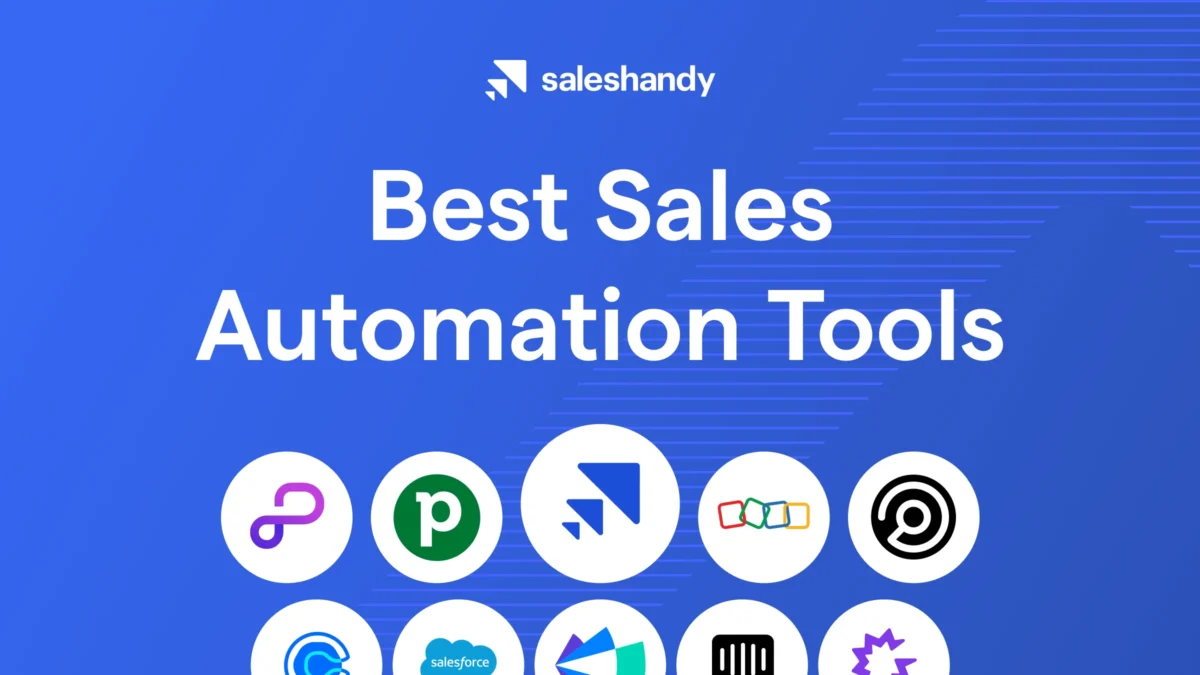Sales automation tools are transforming the way businesses operate. These tools streamline tasks, boost productivity, and help close deals faster.
In 2025, sales automation tools are more advanced and essential than ever. Businesses face tough competition, making it crucial to adopt the best technology. Automation tools can manage leads, follow-ups, and data analysis, freeing up time for sales teams to focus on what they do best: selling.
With the right tools, companies can optimize their sales processes, improve accuracy, and increase revenue. In this blog, we will explore the top sales automation tools that can give your business a competitive edge in 2025.
Introduction To Sales Automation
In the fast-paced world of sales, keeping up with tasks can feel like juggling flaming swords. That’s where sales automation steps in. Think of it as your trusty sidekick, handling repetitive chores so you can focus on what really matters – building relationships and closing deals. But what exactly is sales automation, and why should you care about it in 2025? Let’s dive in.
Importance Of Sales Automation
Sales automation isn’t just a buzzword; it’s a game-changer. Imagine having a team member who never gets tired, never takes breaks, and never makes mistakes. Sounds pretty great, right? By automating routine tasks like data entry, follow-up emails, and lead management, you free up valuable time. This means more energy to spend on strategic activities that boost revenue. In 2025, the tools available are more advanced than ever, making sales automation essential for staying competitive.
Key Benefits In 2025
The benefits of sales automation in 2025 are too good to ignore. Let’s break it down:
- Increased Efficiency: Automation handles mundane tasks, so you can focus on closing deals. This means higher productivity and better use of your time.
- Enhanced Accuracy: Human errors can cost you. Automation ensures data is entered correctly and tasks are completed without mistakes.
- Better Customer Experience: Timely follow-ups and personalized interactions make customers feel valued, improving their overall experience.
- Scalability: As your business grows, automation helps you manage more leads and deals without additional staff.
Imagine being able to spend more time strategizing and less time on data entry. Picture your customers receiving personalized emails that make them feel special. This is the power of sales automation in 2025. It’s like having a superpower in your back pocket, ready to help you conquer the sales world.
In conclusion, sales automation is no longer a luxury; it’s a necessity. As tools become more sophisticated, the potential for growth and efficiency is immense. Embrace sales automation, and watch your sales process transform in ways you never imagined.

Credit: www.dealfront.com
Top Trends In Sales Automation
The landscape of sales automation is evolving rapidly. In 2025, new trends are shaping how businesses approach sales processes. These trends promise to enhance efficiency and productivity. Understanding these trends will help you stay ahead of the competition.
Ai And Machine Learning
AI and machine learning are becoming central to sales automation. These technologies analyze vast amounts of data quickly. This leads to more accurate sales predictions. They also help in identifying potential leads. This means sales teams can focus on high-potential prospects.
Personalization And Customization
Personalization and customization are key trends in 2025. Automated tools now offer tailored experiences for customers. This increases customer satisfaction and loyalty. Customization allows businesses to address specific needs. This trend is making sales strategies more effective.
Criteria For Choosing Sales Automation Tools
Choosing the right sales automation tools can significantly impact your sales team’s efficiency. The best tools help streamline processes, reduce manual tasks, and improve overall productivity. But with so many options available, how do you decide which one to choose?
Ease Of Use
The ease of use is one of the most critical factors. A tool with a user-friendly interface ensures that your team can quickly adapt to it. Look for tools that require minimal training and have intuitive navigation. This reduces the learning curve, allowing your team to start using the tool immediately.
Integration Capabilities
Integration capabilities are essential for a seamless workflow. The best sales automation tools should easily integrate with your existing CRM, email systems, and other software. This ensures that all your data syncs smoothly, eliminating the need for manual data entry. Ensure the tool supports popular integrations to maximize its utility.

Credit: justdigitalinc.com
Hubspot Sales Hub
When it comes to sales automation, HubSpot Sales Hub stands out as a top contender in 2025. This tool is designed to streamline your sales process, making it simpler and more efficient. If you’re looking to boost productivity and close deals faster, HubSpot Sales Hub might just be the solution you need.
Key Features
HubSpot Sales Hub is packed with features that can transform your sales strategy. Here are some of the key highlights:
- Email Tracking: Know when a prospect opens your email, clicks a link, or downloads an attachment. This helps you follow up at the right time.
- Pipeline Management: Organize and track your deals in a visual pipeline. This makes it easy to see where each deal stands and what actions are needed next.
- Meeting Scheduling: Allow prospects to book meetings directly on your calendar without the back-and-forth emails.
- Sales Automation: Automate repetitive tasks like follow-up emails, so you can focus on selling.
- CRM Integration: Seamlessly integrates with HubSpot CRM, providing a unified experience for managing your customer relationships.
Pros And Cons
Like any tool, HubSpot Sales Hub has its strengths and weaknesses. Let’s take a closer look:
| Pros | Cons |
|---|---|
|
|
To sum up, HubSpot Sales Hub is a powerful tool that offers numerous benefits for sales teams. While it does have some downsides, its positives far outweigh the negatives. If you’re looking to enhance your sales process in 2025, HubSpot Sales Hub is definitely worth considering.
Salesforce Sales Cloud
Salesforce Sales Cloud stands out as a robust sales automation tool. It offers a suite of features designed to streamline sales processes. Sales teams can manage leads, track customer interactions, and close deals faster.
Key Features
Salesforce Sales Cloud provides a comprehensive CRM system. It includes lead management, opportunity tracking, and sales forecasting. Users can access real-time dashboards and reports. The AI-powered assistant, Einstein, offers predictive analytics. It helps in making data-driven decisions. Integration with various third-party apps is seamless. Mobile accessibility ensures you stay connected on the go.
Pros And Cons
Pros:
- Highly customizable to fit business needs.
- Strong integration capabilities with other apps.
- Powerful reporting and analytics tools.
- Mobile-friendly interface for on-the-go access.
Cons:
- Can be expensive for small businesses.
- Steep learning curve for new users.
- Requires regular maintenance and updates.
Pipedrive
Pipedrive is one of the leading sales automation tools in 2025. It’s designed with simplicity in mind, making it a favorite among small to medium-sized businesses. If you’re looking to streamline your sales processes and boost productivity, Pipedrive could be the perfect solution. But what exactly makes this tool stand out? Let’s dive into its key features, pros, and cons to find out more.
Key Features
Pipedrive offers a variety of features that cater to different sales needs. Here’s a closer look at some of the most notable ones:
- Visual Sales Pipeline: This feature allows you to see the progress of your deals in a clear and organized way. It’s like having a bird’s eye view of your sales activities.
- Email Integration: Pipedrive integrates seamlessly with your email, helping you track communications and manage follow-ups effortlessly.
- Activity Reminders: Never miss a follow-up again with timely reminders for calls, meetings, and tasks.
- Customizable Dashboards: Tailor your dashboard to show metrics that matter most to you, keeping important data at your fingertips.
- Mobile App: Stay on top of your sales game even when you’re on the go with Pipedrive’s robust mobile app.
Pros And Cons
Like any tool, Pipedrive has its strengths and weaknesses. Here’s a balanced look:
| Pros | Cons |
|---|---|
|
|
So, is Pipedrive worth it? If you’re a small to medium-sized business looking for an intuitive, customizable, and affordable sales automation tool, Pipedrive might just be your best bet. Its user-friendly interface and practical features make it a valuable asset in any sales arsenal. However, if your business requires more advanced features, you might need to explore other options.
Whether you decide to go with Pipedrive or not, remember that the best sales automation tool is the one that fits your specific needs and helps you achieve your sales goals. Happy selling!
Zoho Crm
Zoho CRM is an advanced sales automation tool in 2025. It helps businesses manage customer relationships efficiently. This tool is popular for its user-friendly interface and a wide range of features. Many companies prefer Zoho CRM due to its affordability and versatility. Let’s explore the key features, pros, and cons of Zoho CRM.
Key Features
Zoho CRM offers a variety of features to streamline sales processes.
- Lead Management: Track and manage leads easily.
- Workflow Automation: Automate repetitive tasks to save time.
- AI-Powered Insights: Get actionable insights with AI.
- Customizable Dashboards: Tailor dashboards to meet your needs.
- Multichannel Communication: Engage with customers via email, phone, and social media.
- Integration: Integrate with other Zoho apps and third-party tools.
Pros And Cons
Zoho CRM has its advantages and disadvantages.
Pros:
- Affordable pricing for small and medium businesses.
- Wide range of features and integrations.
- User-friendly interface.
- Excellent customer support.
- Scalable to meet growing business needs.
Cons:
- Advanced features might require a learning curve.
- Customization options can be overwhelming.
- Occasional issues with integration stability.
- Limited offline access.
Comparative Analysis
In the rapidly evolving world of sales automation, choosing the right tool can make or break your team’s efficiency. With 2025 bringing in a slew of innovative options, it’s essential to compare these tools critically. Our comparative analysis will shed light on key aspects such as pricing and customer support to help you make an informed decision. So, let’s dive right in!
Pricing
When it comes to sales automation tools, pricing can vary widely. Some tools offer tiered pricing plans, while others provide a one-time fee. Here’s a breakdown of the most popular options:
| Tool | Basic Plan | Pro Plan | Enterprise Plan |
|---|---|---|---|
| Tool A | $19/month | $49/month | Custom pricing |
| Tool B | $29/month | $69/month | $129/month |
| Tool C | $39/month | $89/month | $159/month |
While Tool A offers the most affordable basic plan, Tool B’s pro plan provides the best value for advanced features. Tool C, though a bit pricier, packs a punch with its comprehensive enterprise package. Ultimately, the choice depends on your budget and the specific needs of your sales team.
Customer Support
Quality customer support can be a game-changer when adopting new technology. Here’s a look at the support options available for each tool:
- Tool A: 24/7 email support, live chat, and a comprehensive knowledge base.
- Tool B: Phone support during business hours, live chat, and an extensive FAQ section.
- Tool C: Dedicated account managers, priority support for enterprise plans, and video tutorials.
If you’re someone who values instant help, Tool A’s 24/7 live chat is a lifesaver. Meanwhile, Tool C’s dedicated account managers provide a personalized touch that can be particularly beneficial for larger teams. And let’s be honest, who doesn’t love a good video tutorial?
In conclusion, both pricing and customer support are crucial factors to consider when choosing the best sales automation tool in 2025. Remember, what works for one company might not work for another. So, weigh your options carefully and choose the tool that aligns best with your needs and budget.
Future Of Sales Automation
Imagine a world where your sales process runs like a well-oiled machine, without you having to lift a finger. Well, the future of sales automation is paving the way for this dream to come true. In 2025, we can expect sales automation tools to not only simplify tasks but to revolutionize the way businesses operate. From predicting customer needs to personalizing every interaction, the advancements are nothing short of mind-blowing.
Emerging Technologies
Let’s dive into the exciting world of emerging technologies. These are the tools and innovations that will shape the future of sales automation:
- Artificial Intelligence (AI): AI will become the backbone of sales strategies, predicting trends and automating repetitive tasks.
- Machine Learning (ML): ML algorithms will analyze vast amounts of data, providing insights that were previously unimaginable.
- Chatbots: These friendly virtual assistants will handle customer queries, ensuring round-the-clock support.
- Blockchain: Securing transactions and ensuring transparency in sales processes.
These technologies will work together to create a seamless sales experience, making life easier for both businesses and customers.
Evolving Customer Expectations
As we move forward, customer expectations are evolving at lightning speed. Here’s what customers will be looking for in 2025:
- Personalization: Customers want tailored experiences. Sales automation tools will gather and analyze data to create personalized interactions.
- Speed: Instant gratification is the name of the game. Quick responses and fast transactions will be essential.
- Transparency: Trust is key. Customers will demand clear and honest communication.
- Omni-channel Experience: Seamless integration across various platforms and devices will be a must.
Meeting these expectations will require leveraging the latest sales automation tools. It’s like playing a game of chess, but with technology making all the right moves for you.
In conclusion, the future of sales automation in 2025 is not just about making things easier; it’s about transforming the entire sales landscape. With emerging technologies and evolving customer expectations, businesses that adapt will thrive, and those that don’t, well, they might just miss the boat. So, are you ready to embrace the future?

Credit: www.bairesdev.com
Frequently Asked Questions
What Is The Most Used Automation Software?
The most used automation software is UiPath. It is popular for robotic process automation (RPA). UiPath streamlines business processes efficiently.
How Big Is The Sales Automation Industry?
The sales automation industry is valued at around $2. 9 billion in 2023. It’s projected to grow significantly in the coming years.
Which Platform Is Best For Automation?
The best platform for automation depends on your needs. Popular options include Zapier, UiPath, and Automation Anywhere.
Which Is The Best Marketing Automation Tool?
HubSpot is widely considered the best marketing automation tool. It offers comprehensive features for email marketing, CRM, and analytics.
Conclusion
Sales automation tools in 2025 streamline your sales process. They save time and boost productivity. Choose tools that fit your business needs. Evaluate features, pricing, and user reviews. Implementing these tools can lead to better results. Stay ahead by embracing new technologies.
Your sales team will thank you. Invest in the right tools today. Your business growth depends on it.

